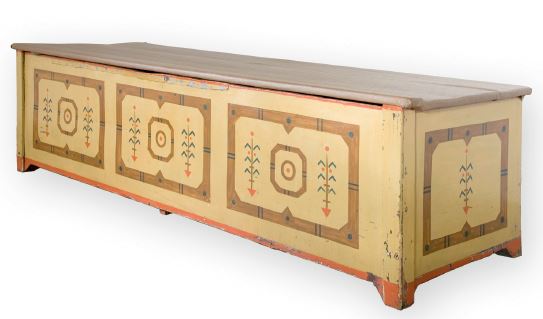Ľubomír Longauer
Slovak painter Martin Benka started his career as an art craftsman and was influenced particularly by wood. His father was a carpenter and he himself believed to become a wood-carver. In general, Benka´s artwork such as violins, architectural drawings, an altar and the interior of the chapel in Spišská Kapitula possesses the same artistic expression which is typical for his graphic design works. Benka sought to develop a national style which he advocated and pursued throughout his lifetime.
As a young apprentice, Benka came to capital of multinational state Vienna in 1906. Then, he came to Prague and lived there for 30 years. Finally, he returned back to Martin, Slovakia. The shapes he used in the national style he had developed are rooted in his youth, the Secession style and the Czech Rondocubism. Benka added what he had believed was the Slovak influence to it. However, the elements he added were more his personal expression than the national elements. Benka devoted most of his creative potential to the development of national style in the late 1930s and the early 1940s. His creative potential declined under the pressure of socialist era. Fortunately, he did not surrender totally and applied his creative individual personality, particularly in small utility objects.
Among Benka´s first designs were frames for his paintings he made in the 1930s. Like the frames, many other design attempts he made are only drawings, not realisations.
Benka returned to refracted angles of the Czech Cubism in his designs of peace cups and applied his designs from the 1930s. However, he failed to design the national souvenir. His designs clashed with then-popular functionalist style and were never produced. After many years, the shapes and artistic expression of his vases are recognised as a unique phenomenon in the Slovak design. Benka, not trained as an interior architect, made furniture designs for his house in the mid 1950s. Among the most recognised works in wood are the altar and interior design of the chapel in Spišská Kapitula which are deemed to be his design attempts. Violins are a special chapter in Benka´s work as a designer. He made his first violins in the late 1930s and continued to make them until the late 1960s. The shapes of the violins are recognised as the top of his designing work.
The majority of his utility designs were never realised. They were too national for some and too conservative for others which is strange because Benka was a true stylist. Thus, Martin Benka may be considered the predecessor of contemporary designers.
